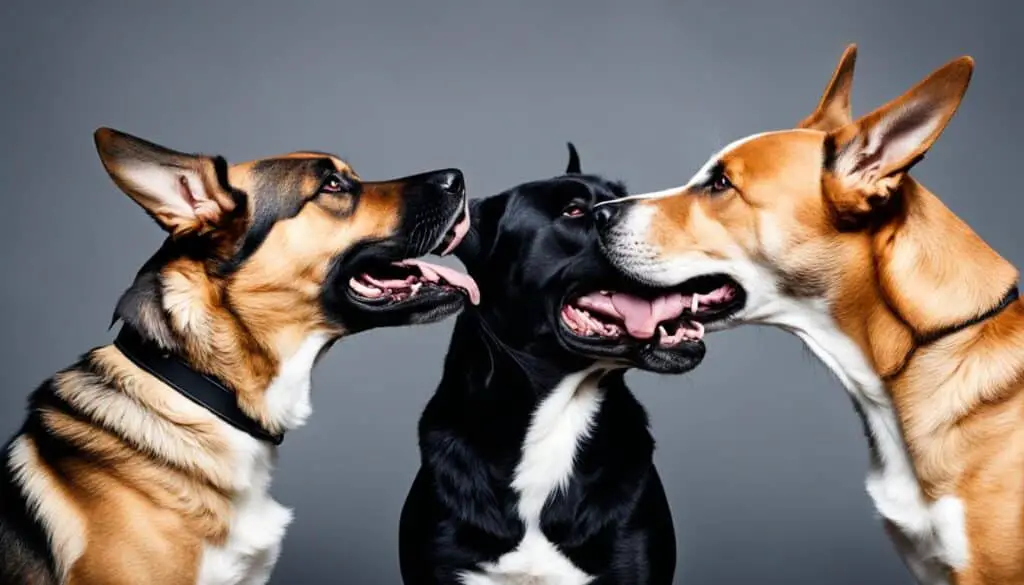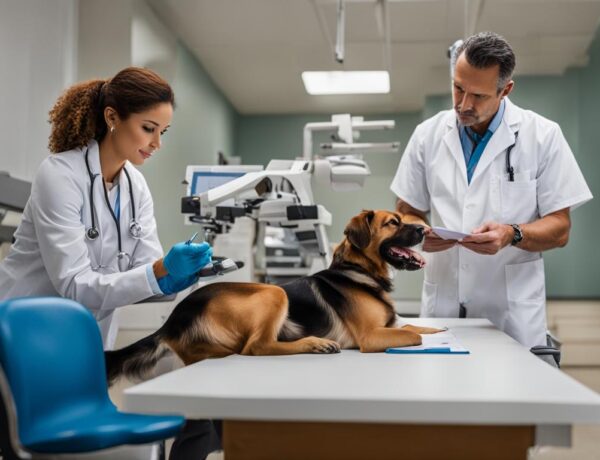Aggression in pets is a common concern for many pet owners. Understanding the differences in aggression between male and female small pets is crucial for providing them with the best care and addressing any behavioral challenges that may arise.
Research and studies on animal behavior have shed light on the topic, revealing that individual variation in behavior exists within species. Studies conducted on various animals, such as cichlids, geese, rainbow trout, starlings, and lizards, have shown that behaviors can be consistent over time and influenced by factors such as sexual selection and sexual dimorphism.
By delving into these findings and applying them to our understanding of aggression in male and female small pets, we can gain valuable insights into their behavior and find effective ways to manage and alleviate aggression-related issues.
Key Takeaways:
- Aggression in male and female small pets can vary based on individual behavior and species-specific characteristics.
- Understanding the factors that contribute to aggression can help pet owners address and manage aggressive behaviors effectively.
- Research has shown that sexual selection and sexual dimorphism play a role in aggression differences between male and female animals.
- Building a strong emotional connection with your pet is essential in managing and preventing aggression.
- Seeking professional guidance and training can be beneficial in addressing aggression issues in pets.
Loyalty and Emotional Connection in Male and Female Dogs
The idea that female dogs tend to be more loyal than males has been a long-standing myth. While it is true that male dogs may exhibit more exploratory behavior and have a tendency to roam, loyalty and emotional connection are not solely determined by gender. Research suggests that earned loyalty can be established through grooming and bonding activities with your pet. Grooming and spending quality time with your dog can strengthen the emotional connection between you and your pet, regardless of their gender.
Building a strong emotional connection with your dog involves nurturing the bond through daily activities. Regular grooming sessions, such as brushing their coat, cleaning their ears, and trimming their nails, not only contribute to their physical well-being but also create moments of intimate connection. It’s an opportunity to show your love and care, while also promoting relaxation and trust.
Additionally, engaging in activities that both you and your dog enjoy can further enhance the emotional connection between you. Going for walks, playing games, and training together provide opportunities for positive reinforcement and shared experiences. These moments of joy and interaction strengthen the bond and solidify the loyalty your dog feels towards you.
It is worth noting that loyalty and emotional connection can vary between individual dogs. Each dog has their own unique personality and temperament, which can influence their loyalty and attachment. The key is understanding your dog’s needs, preferences, and boundaries, and providing a nurturing environment that fosters trust and emotional well-being.
The Role of Gender in Loyalty
While loyalty is not solely determined by gender, it is important to recognize that certain breed traits or individual tendencies may influence loyalty in male and female dogs. For example, some breeds are known for their strong loyalty and dedication to their owners, regardless of their gender. Understanding breed characteristics can help you choose a dog that aligns with your preferences for loyalty and emotional connection.
| Gender | Breed Examples | Characteristics |
|---|---|---|
| Male | Labrador Retriever | Loyal, friendly, and eager to please |
| Female | German Shepherd | Loyal, protective, and intelligent |
| Male | Golden Retriever | Loyal, sociable, and patient |
| Female | Border Collie | Devoted, agile, and highly trainable |
The table above provides examples of loyal breeds, showcasing both male and female dogs that are known for their loyalty and emotional connection with their owners. It is important to remember that individual variation exists within each breed, and loyalty can also be influenced by factors such as training, socialization, and overall care.
Spending quality time with your dog and engaging in activities that promote bonding can strengthen the loyalty and emotional connection between you and your pet.
Aggression and Emotional Connection in Male and Female Dogs
Aggression is not exclusive to any gender and should not be interpreted as a hindrance to emotional connection with your dog. Both male and female dogs can display aggressive behavior, but it is important to understand that aggression is primarily influenced by training and treatment, rather than gender alone.
Male dogs may exhibit aggression based on social order and dominance within their pack. This aggression is often directed towards other dogs or in certain territorial situations. On the other hand, female dogs, when aggressive, may pose a greater risk of harm due to their size and strength. However, it is crucial to remember that aggression is not a defining characteristic of either gender.
As a responsible pet owner, it is essential to educate others on how to interact with your dog and ensure their safety. Preventing uncomfortable or scary situations can be achieved through proper training and socialization. Building a strong emotional connection with an aggressive dog requires patience, consistent training, and understanding.
“Aggression is more influenced by training and treatment than gender.”
Take the time to establish trust and create a positive association with your dog through reward-based training methods. Seek professional help if necessary to address aggressive behavior, as early intervention can lead to significant improvements.
Training Techniques to Build Emotional Connection with an Aggressive Dog
- Positive Reinforcement: Utilize rewards such as treats and praise to reinforce good behavior, helping your dog associate positive experiences with appropriate actions.
- Socialization: Gradually expose your dog to different people, animals, and environments to reduce fear-based aggression and build confidence.
- Consistency: Maintain a consistent routine and set clear boundaries to establish trust and security for your dog.
- Patience: Understand that progress may take time and setbacks can occur. Stay patient and persistent in your training efforts.
Remember, an aggressive dog can still form a deep emotional connection with their owner when treated with love, care, and understanding. By addressing aggressive behavior and building a strong bond, you can create a harmonious and fulfilling relationship with your canine companion.
Common Types of Aggression in Dogs
| Aggression Type | Description |
|---|---|
| Resource Guarding | Dogs become aggressive when protecting their food, toys, or other valuable possessions. |
| Territorial Aggression | Protective behavior exhibited when defending their territory, such as their home or yard. |
| Fear Aggression | Dogs display aggression when encountering situations or stimuli they perceive as threatening or fearful. |
| Redirected Aggression | Aggressive behavior exhibited towards a person or animal due to frustration or arousal from an unrelated source. |
| Defensive Aggression | Dogs react defensively when they feel threatened or cornered, often displaying growling, snarling, or biting. |
Friendliness and Affection in Male and Female Dogs
When it comes to friendliness and affection in dogs, gender does not play the determining role. Rather, these qualities are closely linked to the individual dog’s personality and breed characteristics. While certain breeds may have a reputation for being more friendly and affectionate, it is important to note that this is not exclusive to one gender over the other.
Choosing a pet should involve considering the breed’s traits and how they align with your lifestyle. Some breeds are known to be inherently friendly and affectionate, making them excellent choices for those seeking an affectionate companion. However, it is crucial to remember that there can be variations within a breed, and each dog may have its own unique personality.
Regardless of gender, friendly dogs have the potential to form strong emotional connections with their owners. These connections are built through love, care, and quality time spent together. By providing a nurturing environment and engaging in activities that promote bonding, such as playtime and grooming, you can cultivate a loving relationship with your pet.
The Role of Breed in Friendliness and Affection
While gender may not be the primary factor determining friendliness and affection, certain dog breeds are commonly associated with these qualities. Here are some examples of breeds that are often recognized for their friendly and affectionate nature:
- Labrador Retriever: Known for their playful and outgoing nature, Labs are often friendly and affectionate towards both their owners and strangers.
- Golden Retriever: A popular choice for families, Golden Retrievers are known for their gentle demeanor and friendly disposition.
- Beagle: Beagles are often described as sociable, friendly, and affectionate dogs, making them great companions.
- Cavalier King Charles Spaniel: These small breed dogs are known for their affectionate and friendly nature, making them ideal for individuals seeking a lap dog.
While these breeds are generally considered friendly and affectionate, it is important to note that individual dogs may differ in their behavior. Proper socialization, training, and positive reinforcement can significantly influence a dog’s friendliness and affection levels, regardless of their breed or gender.
Building an Affectionate Bond
Building an affectionate bond with your dog requires time, patience, and consistent effort. Here are a few tips to help you strengthen the connection with your furry friend:
- Spending quality time together: Engage in activities that your dog enjoys, such as going for walks, playing fetch, or simply cuddling on the couch.
- Positive reinforcement training: Use positive reinforcement techniques to reward desired behaviors and strengthen the bond between you and your dog.
- Grooming and physical touch: Regular grooming sessions, such as brushing, can provide an opportunity for bonding and physical touch, promoting affection.
- Show love and affection: Express your love for your dog through verbal praise, gentle petting, and hugs. Dogs thrive on affection and will reciprocate the love you show them.
Remember, every dog is unique, and it’s important to understand and respect their individual needs and preferences. By providing a loving and nurturing environment, you can cultivate a strong and affectionate bond with your pet, regardless of their gender.
Friendliness and Affection in Popular Dog Breeds
| Breed | Friendliness Level | Affection Level |
|---|---|---|
| Labrador Retriever | High | High |
| Golden Retriever | High | High |
| Beagle | Medium | High |
| Cavalier King Charles Spaniel | High | High |
Understanding Cat Behavior: Affiliative and Aggressive Tendencies
When it comes to understanding cat behavior, it’s important for pet owners to recognize the differences in affiliative and aggressive tendencies. Research conducted on domestic cats, especially in outdoor environments, has shed light on the various behaviors exhibited by our feline friends.
One key aspect of cat behavior is affiliative behavior, which refers to social interactions and bonds formed between cats. Affiliative behaviors can include allogrooming, where cats groom each other, and allorubbing, where they rub against one another.
Interestingly, studies have indicated that female cats tend to showcase more affiliative behavior than their male counterparts. This tendency suggests that female cats may be more oriented towards social bonding and establishing relationships within their feline communities.
On the other hand, aggression is another behavior that can be observed in cats. Aggression can occur between males, females, and even between males and females. However, it’s essential to note that aggression rates and tendencies can be influenced by various factors, such as neutering and the length of time cats have lived together.
To better understand these behaviors, let’s take a look at the following table:
| Behavior | Differences Between Male and Female Cats |
|---|---|
| Affiliative Behavior | Female cats tend to exhibit more affiliative behavior, such as allogrooming and allorubbing. |
| Aggressive Behavior | Aggression can be observed in both male and female cats, with rates influenced by factors like neutering and social dynamics. |
Understanding these behaviors can help pet owners create a harmonious environment for their cats and foster positive relationships between feline companions. By providing appropriate socialization opportunities and a safe, enriched living space, owners can support their cats in exhibiting healthy and balanced behaviors.
Conclusion
Understanding pet behavior, including aggression, and establishing an emotional connection with our beloved pets is an essential part of being a responsible pet owner. This complex topic requires us to consider various factors that contribute to aggressive tendencies in male and female small pets. From individual behaviors to training methods and breed characteristics, there is no one-size-fits-all approach to understanding pet aggression.
It is important to remember that each pet is unique and should be evaluated on an individual basis. While there may be general trends in behavior, it is crucial to assess your pet’s behavior in the context of their own personality and experiences.
Creating a strong emotional connection with our pets requires time, effort, and understanding. Incorporating positive reinforcement training techniques and providing a nurturing environment can greatly contribute to fostering a loving relationship. By focusing on building trust, respect, and effective communication with our pets, we can overcome aggression challenges and establish a deep bond, regardless of their gender.
FAQ
Are there aggression differences between male and female small pets?
Yes, there can be differences in aggression between male and female small pets. Research has shown that individual variation in behavior exists within species, and behaviors can be consistent over time. Understanding these differences can help pet owners better address and manage aggression in their pets.
Do male dogs tend to be more loyal than females?
No, loyalty and emotional connection are not solely determined by gender in dogs. Research suggests that earned loyalty can be established through grooming and bonding activities with your pet. Both male and female dogs can form strong emotional connections with their owners.
Is aggression more influenced by training or gender in dogs?
Aggression in dogs is more influenced by training and treatment than by gender. Male dogs may exhibit social order-based aggression, while female dogs, when aggressive, may cause more harm. It is important for pet owners to be responsible and educate others on how to interact with their dogs to prevent uncomfortable or scary situations.
Is friendliness and affection linked to the gender of dogs?
No, friendliness and affection in dogs are more closely linked to the individual dog’s personality and breed characteristics than their gender. While certain breeds may have a reputation for being more friendly and affectionate, it is not a strict rule that one gender is more friendly than the other.
Do male and female cats exhibit different affiliative and aggressive behaviors?
Yes, research has shown that female cats tend to show more affiliative behavior than males. However, aggression in cats can occur between males, females, and between males and females. Factors such as neutering and the length of time cats have lived together can influence aggression rates and tendencies.
How can I build an emotional connection with my pet?
Building an emotional connection with your pet requires time, effort, and understanding. Incorporating positive reinforcement training and creating a nurturing environment can help foster a loving relationship with your pet, regardless of their gender.







No Comments